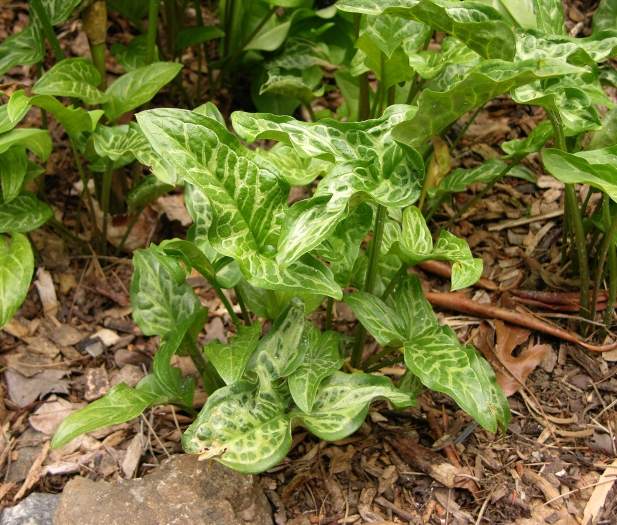Italian Lords-And-Ladies
(Arum italicum)
Italian Lords-And-Ladies (Arum italicum)
/
/

(c)2007 Derek Ramsey (Ram-Man)
GFDL 1.2
Image By:
(c)2007 Derek Ramsey (Ram-Man)
Recorded By:
Copyright:
GFDL 1.2
Copyright Notice:
Photo by: (c)2007 Derek Ramsey (Ram-Man) | License Type: GFDL 1.2 | License URL: http://www.gnu.org/licenses/old-licenses/fdl-1.2.html | Uploader: Ram-Man | Publisher: Wikimedia Commons | Title: Cuckoo_Pint_Arum_italicum_Young_Plant_2874px.jpg | Notes: |
























































Estimated Native Range
Summary
Arum italicum, commonly known as Italian Lords-and-Ladies, is a perennial herb native to a variety of habitats including open woodlands, forest edges, and riparian zones across Europe and the Mediterranean region. It typically grows to a height and spread of 30–46 cm (1–1.5 ft). The plant features large, arrow-shaped leaves with distinctive pale veins, and in the spring, it produces a pale green spathe that surrounds a spadix, which is followed by a cluster of bright red berries that are highly ornamental but toxic if ingested. The foliage is particularly attractive during the winter months when many other plants are dormant.
Italian Lords-and-Ladies is valued for its attractive foliage and berries, which add interest to shade gardens throughout the year. It is often used in traditional and woodland gardens, as well as in border plantings or as ground cover. This plant pairs well with Hostas, providing a succession of foliage as the Hosta dies back in winter. It thrives in part shade to full shade and prefers moist, well-drained soil, although it can tolerate a range of soil drainage conditions. While it requires medium amounts of water, it is relatively low maintenance once established.CC BY-SA 4.0
Italian Lords-and-Ladies is valued for its attractive foliage and berries, which add interest to shade gardens throughout the year. It is often used in traditional and woodland gardens, as well as in border plantings or as ground cover. This plant pairs well with Hostas, providing a succession of foliage as the Hosta dies back in winter. It thrives in part shade to full shade and prefers moist, well-drained soil, although it can tolerate a range of soil drainage conditions. While it requires medium amounts of water, it is relatively low maintenance once established.CC BY-SA 4.0
Plant Description
- Plant Type: Herb
- Height: 1-1.5 feet
- Width: 1-1.5 feet
- Growth Rate: Moderate
- Flower Color: Green, Yellow
- Flowering Season: Spring
- Leaf Retention: Evergreen
Growth Requirements
- Sun: Part Shade, Full Shade
- Water: Medium
- Drainage: Fast, Medium, Slow
Common Uses
Groundcover, Low Maintenance, Potted Plant, Rock Garden
Natural Habitat
native to a variety of habitats including open woodlands, forest edges, and riparian zones across Europe and the Mediterranean region
Other Names
Common Names: Italian Arum , Italian Lords-And-Ladies , Pidyn-Y-Gog Eidalaidd , Italiensk Ingefær , Italienischer Aronstab , Gouet Ditalie , Cluas Chaoin Riabhach , Italiaanse Aronskelk , Italiensk Munkhätta
Scientific Names: Arum italicum , Arum italicum var. italicum , Arisarum italicum , Arum maculatum var. italicum
GBIF Accepted Name: Arum italicum Mill.